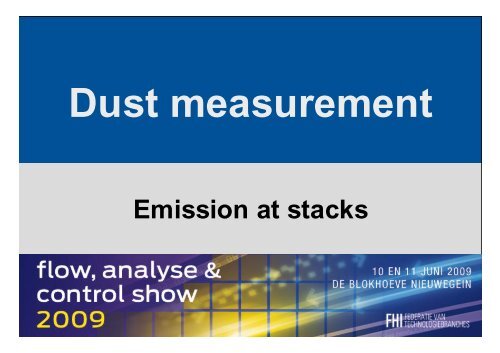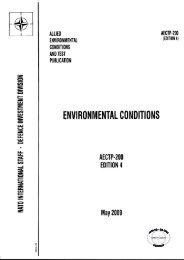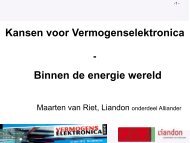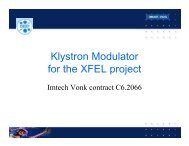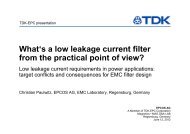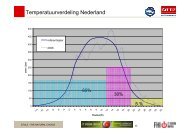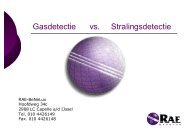Dust measurement
Dust measurement
Dust measurement
You also want an ePaper? Increase the reach of your titles
YUMPU automatically turns print PDFs into web optimized ePapers that Google loves.
<strong>Dust</strong> <strong>measurement</strong><br />
Emission at stacks
<strong>Dust</strong> <strong>measurement</strong><br />
• DUST (definition as per EN 13284)<br />
• Particles of any kind ….<br />
- which remain inside of the sampling device or on<br />
the filter of the representative sample extraction<br />
device after drying … (EN 13284-1)<br />
Seite 1
<strong>Dust</strong> <strong>measurement</strong> – monitored parameters<br />
Opacity ?<br />
Optical transmission<br />
legally<br />
restricted<br />
<strong>Dust</strong><br />
concentration ?<br />
Optical density<br />
scattered light / flicker light<br />
tribo flow, beta gauge<br />
legally<br />
restricted<br />
Process<br />
control ?<br />
Optical density<br />
scattered light / flicker light<br />
tribo flow<br />
free<br />
Seite 2
<strong>Dust</strong> <strong>measurement</strong><br />
Base of dust concentration <strong>measurement</strong> is a manual method<br />
= Standard Reference Method (SRM)<br />
Automatic Analyser Systems (AMS) for dust concentration <strong>measurement</strong> do not<br />
directly measure the dust concentration, but any other physical attribute of dust.<br />
Optical attributes (optical density, scattered light, flicker light)<br />
Other attributes (triboelectric effect, beta ray absorption)<br />
For dust concentration <strong>measurement</strong> any AMS is used which has to be<br />
calibrated at the site using the SRM. The selection of an AMS depends on<br />
individual plant parameters (stack size, temperature, gas humidity et al.)<br />
Instead of the parameter „dust concentration“ some countries claim to measure<br />
the dust attribute opacity. Then you are obliged to use the prescribed method<br />
Seite 3
<strong>Dust</strong> <strong>measurement</strong> – monitored parameters<br />
Opacity<br />
<strong>Dust</strong> Concentration (PM) Measurement<br />
SRM<br />
single<br />
dual<br />
Standard<br />
Reference<br />
Method<br />
EN 13284-1<br />
EPA<br />
40CFR60 PS1<br />
EPA<br />
40CFR60 PS11<br />
AMS: Automatic Measuring<br />
System<br />
EN 13284-2<br />
Seite 4
General requirements for online dust monitoring<br />
Government<br />
- defines parameters/limits to be measured<br />
- defines maximum allowed uncertanty<br />
- forces manufacturer to certify analyser<br />
- forces owner to check and verify results<br />
- forces owner to report measuring results<br />
- might define tech. details of the analyser<br />
Manufacturer<br />
- offers various analysing methods<br />
- includes automatic adjust proc.<br />
- provides for test certificates<br />
- includes „tools“ to the analyser<br />
- provides for interface to DCS<br />
- follows definition<br />
Plant owner<br />
- selects analyser type which fits best<br />
- provides for third party installation certificate<br />
- provides for third party calibration<br />
- continuously maintains and checks analyser<br />
- provides for quality assurance test protocols<br />
Seite 5
Opacity<br />
Opacity<br />
Parameter which<br />
describes optical<br />
attribute of dust<br />
Ringelmann scale<br />
0 1 2 3 4 5<br />
0% 20% 40% 60% 80% 100%<br />
Opacity<br />
single<br />
dual<br />
The Opacity of dust at the stack outlet<br />
is continuously monitored in USA and<br />
related regions following<br />
EPA 40CFR60 PS 1<br />
Seite 6
Opacity - Transmission<br />
Opacity - Transmission<br />
two sides of a medal!<br />
Light source<br />
Transmission<br />
detector<br />
Light will interact with dust<br />
particles by<br />
• deflection<br />
• diffraction<br />
• absorption<br />
Light intensity is decreased<br />
dependant on<br />
• particle shape/ size<br />
• particle concentration<br />
• length of optical path<br />
L<br />
Seite 7
Opacity - characteristics<br />
Uncertanty on principle<br />
Strategy to overcome<br />
1. aging of light source -> internal optical adjustment<br />
2. aging of detector -> internal optical adjustment<br />
3. misalignment of optical path -> design (homogenous light beam)<br />
4. soiling of optical window -> measure and compensate soiling<br />
Seite 8
3<br />
<strong>Dust</strong>Contentmg/Nm<br />
Standard Reference Method (SRM) EN13284-1<br />
D-R 290<br />
Optical Density Value<br />
1<br />
1<br />
2<br />
14<br />
13<br />
12<br />
3<br />
11<br />
5<br />
6<br />
7<br />
8<br />
9<br />
<strong>Dust</strong> Content mg/m 3<br />
125<br />
100<br />
75<br />
50<br />
25<br />
Y3<br />
Y1<br />
Y<br />
Y2<br />
Y4<br />
Gravimetric Weight<br />
∆m = m 2<br />
– m 1<br />
∆m<br />
Volume<br />
0<br />
0 0.1 0.2 0.3 0.4 0.5<br />
Optical Density (Extinction)<br />
<strong>Dust</strong> Penetration<br />
m 1<br />
(before)<br />
m 2<br />
(after)<br />
Weight of Fabric Filter<br />
1 tubular f ilter with probe and diffuse<br />
2 suction tube<br />
3 shutoff device<br />
4 dry ing tow<br />
5 protective filterf or pump<br />
6 pump (gas-tight)<br />
7 regulating by -pass<br />
8 rotameter<br />
9 gas v olume meter with thermometer<br />
10 barometer<br />
11 stop watch<br />
12 thermometer<br />
13 Prandtl-ty pe Pitot head with micromanometer,<br />
alternativ ely anemometer<br />
14 gas analyser, if necessary<br />
Seite 9
mA<br />
20<br />
20mA<br />
20mA<br />
20mA<br />
20mA<br />
20mA<br />
AMS Opacity / Optical Density<br />
An opacity analyser can be<br />
used as AMS for dust<br />
concentration <strong>measurement</strong>.<br />
Instead of using the dust<br />
attribute Opacity the attribute<br />
Extinction (Optical Density) is<br />
used as output because this<br />
attribute is proportional to the<br />
dust concentration!<br />
The „factor“ a1 to calculate the<br />
dust concentration from output<br />
extinction is dependant on<br />
- length of optical path<br />
- dust characteristics<br />
- diameter, shape, color<br />
Extinction (E)<br />
1,6<br />
1,5<br />
1,4<br />
1,3<br />
1,2<br />
1,1<br />
1,0<br />
0,9<br />
0,8<br />
0,7<br />
0,6<br />
0,5<br />
0,4<br />
0,3<br />
0,2<br />
0,1<br />
Transmission (T) % 100<br />
Opacity (Op) % 0<br />
T =<br />
I I<br />
0<br />
E = lg — 1 T<br />
79,4%<br />
80<br />
20<br />
Op = 100-T [%]<br />
39%<br />
63%<br />
10%<br />
15,8%<br />
2,5%<br />
60 40 20 0<br />
40 60 80 100<br />
Seite 10
AMS (Optical Density) linearity check<br />
• “Simple to use” reference material!<br />
• On-stack linearity check<br />
• Different calibration attenuators<br />
available<br />
• Different executions:<br />
- traceable to NIST standards<br />
Seite 11
AMS (Optical Density)<br />
Advantages<br />
- reliable<br />
- easy to check<br />
performance with<br />
opacity filters<br />
- analyser outside of<br />
stack<br />
Disadvantages<br />
- 0 EXT = 100%T<br />
-> restricted accuracy if<br />
C*L is very low<br />
- r.H. < 95%<br />
Seite 12
AMS (Optical Density)<br />
If C * L becomes too low (limit dependant on analyser type and dust specs.)<br />
C = limit value (in mg/m3)<br />
L = diameter of the stack<br />
It is time to say „goodbye“ for transmission method<br />
and say „hello“ to scattering method!<br />
Attention!<br />
The light beam does not know the difference between water droplets and dust!<br />
-> use optical methods only for dry gas (< 95% r.H)<br />
-> for wet gas use extractive systems where heaters remove the water droplets<br />
prior to analysis via beta ray or optical sensors<br />
Seite 13
AMS (Scattered light monitor)<br />
Detector position<br />
1. Transmission<br />
2. Scattered light<br />
backwards<br />
3. Scattered light<br />
forwards<br />
Light source<br />
2<br />
3<br />
1<br />
Seite 14
AMS (Scattered light monitor (scattering backwards))<br />
Fail safe shutter (optional)<br />
Advantages<br />
Light trap<br />
A second light trap<br />
is required for smoke<br />
spot number (soot)<br />
measuring<br />
Emitted light<br />
Measuring<br />
volume<br />
Stray light<br />
D-R 300-40<br />
Measuring head<br />
Control display<br />
- reliable „zero“ signal<br />
- very sensitive<br />
- result independant<br />
from stack diameter<br />
- analyser outside of<br />
stack<br />
Disadvantages<br />
Waste gas<br />
Purge air fan<br />
Line recorder<br />
-„blind“ for high<br />
concentrations<br />
- signal verification<br />
- single point<br />
<strong>measurement</strong><br />
- r.H. < 95%!<br />
Seite 15
AMS (Scattered light monitor (scattering forwards))<br />
Purging Air<br />
Fibre Opti c<br />
Pane<br />
Recei ver<br />
Di ode<br />
Ref erence Light Beam<br />
Measuring Light Beam<br />
Shutter<br />
Beam<br />
S plitter<br />
Transmi tter<br />
Di ode<br />
Light Trap<br />
Obj ective<br />
Measuring<br />
Vol ume<br />
Cleaning<br />
Flange<br />
Advantages<br />
- reliable „zero“ signal<br />
- result independant<br />
from stack diameter<br />
- simple design<br />
Disadvantages<br />
-„blind“ for high<br />
concentrations<br />
- signal verification<br />
- single point <strong>measurement</strong><br />
- probe inside of stack<br />
- r.H < 95%!<br />
Seite 16
Tribo flow<br />
Advantages<br />
Isolator<br />
Probe<br />
- simple<br />
- sensitive<br />
- economical<br />
- nice for qualitative <strong>measurement</strong><br />
Disadvantages<br />
-„blind“ for high concentrations<br />
- dependant on flow speed<br />
- dependant on humidity<br />
- signal verification<br />
- cannot be used behind electric<br />
precipitators<br />
- r.H 20..80%<br />
Seite 17
Tribo flow (application)<br />
4 – 20 mA<br />
<strong>measurement</strong><br />
output<br />
emission peak indicates<br />
location of defective bag<br />
limit value<br />
cleaning puls missing:<br />
valve defect<br />
normal cleaning pulses<br />
Time<br />
Seite 18
Tribo flow (application)<br />
2<br />
Measuring point 2:<br />
Filter Monitor installed correct: high gas velocity<br />
because of small cross section, and long probe<br />
Measuring point 3:<br />
Filter Monitor<br />
installed incorrect:<br />
only short probe<br />
possible<br />
3<br />
clean gas<br />
bag house<br />
Measuring point 1:<br />
Filter Monitor installed<br />
incorrect: only low gas<br />
velocity because of large<br />
cross section<br />
1<br />
raw gas<br />
Seite 19
AMS Extractive dust <strong>measurement</strong> w. beta ray absorption<br />
Sample Probe, Nozzle<br />
Valve<br />
Cover Foil<br />
(optional)<br />
Filter Advance<br />
Stepping Motor<br />
Take-up<br />
Reel<br />
Pressurized Air<br />
Tape-Filter Printer (optional)<br />
Counter Tube<br />
C-14 Source<br />
Filter-Adapter<br />
Supply Reel<br />
PLC<br />
Sample Cooler with<br />
Automatic Drain<br />
4-20mA<br />
STATI<br />
Total Flow<br />
Vacuum Pump<br />
with Bypass<br />
Controller<br />
Exhaust<br />
Stack<br />
Dilution Gas<br />
Venturi Nozzle<br />
Advantages<br />
- direct gravimetric <strong>measurement</strong><br />
- reliable<br />
- suitable for wet stack gas<br />
Disadvantages<br />
- acceptance of beta ray principle<br />
Seite 20
Lars Platzhoff<br />
DURAG GROUP<br />
Director Sales & Service Europe<br />
Kollaustraße 105, 22453 Hamburg, Germany<br />
Tel.: +49-4055 42 18-0, Fax: +49-2102-7400-28<br />
www.DURAG.de, eMail:Lars.Platzhoff@DURAG.de<br />
page 21 page 21<br />
Seite 21


